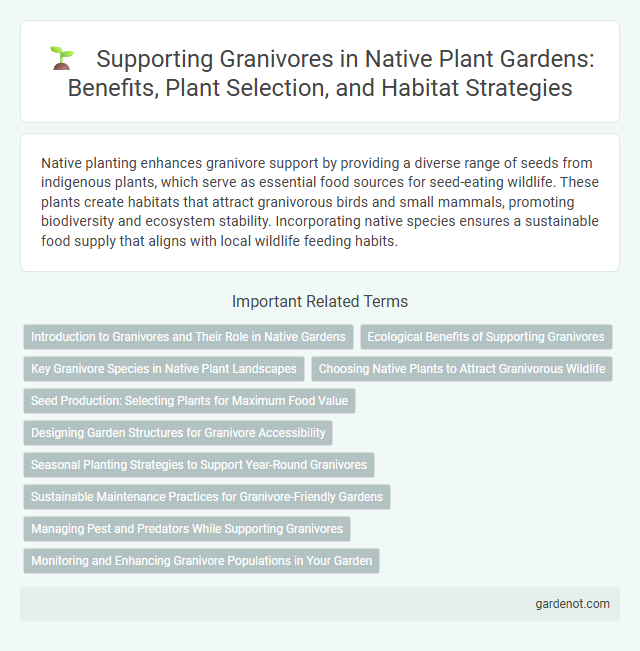Native planting enhances granivore support by providing a diverse range of seeds from indigenous plants, which serve as essential food sources for seed-eating wildlife. These plants create habitats that attract granivorous birds and small mammals, promoting biodiversity and ecosystem stability. Incorporating native species ensures a sustainable food supply that aligns with local wildlife feeding habits.
Introduction to Granivores and Their Role in Native Gardens
Granivores are animals specialized in consuming seeds, playing a crucial role in seed dispersal and population control in native gardens. Species such as birds, rodents, and insects contribute to maintaining plant biodiversity by influencing seed germination and distribution patterns. Encouraging granivore presence supports natural regeneration processes and enhances ecosystem resilience within native planting landscapes.
Ecological Benefits of Supporting Granivores
Native planting enhances granivore populations by providing a diverse array of seeds essential for their diet, supporting species such as sparrows, finches, and rodents. These granivores contribute to seed dispersal and germination, promoting plant diversity and forest regeneration. Maintaining granivore habitats through native vegetation improves ecosystem resilience and stability by sustaining trophic interactions and nutrient cycling.
Key Granivore Species in Native Plant Landscapes
Key granivore species integral to native plant landscapes include ground-feeding birds such as sparrows, juncos, and doves, which play a crucial role in seed dispersal and ecosystem balance. Small mammals like chipmunks and desert rodents contribute significantly by consuming and caching seeds, facilitating plant regeneration across diverse habitats. These granivores help maintain native plant diversity by naturally managing seed distribution and promoting resilient, self-sustaining ecosystems.
Choosing Native Plants to Attract Granivorous Wildlife
Selecting native plants with abundant seeds enhances granivore support by providing essential food sources for seed-eating birds and small mammals. Species such as coneflowers (Echinacea), sunflowers (Helianthus), and native grasses offer high-quality seeds throughout the growing season. Incorporating diverse native seed-producing plants in landscaping promotes a balanced ecosystem and sustains granivorous wildlife populations effectively.
Seed Production: Selecting Plants for Maximum Food Value
Selecting native plant species rich in high-fat, nutrient-dense seeds enhances granivore support by providing essential energy sources crucial for bird and small mammal survival. Prioritize plants like sunflower (Helianthus spp.), oak (Quercus spp.), and hazelnut (Corylus spp.) for their prolific seed production and nutritional profile. Maximizing seed yield and diversity sustains granivore populations and promotes ecosystem resilience.
Designing Garden Structures for Granivore Accessibility
Designing garden structures that enhance granivore accessibility involves incorporating varied seed sources and strategic placement to attract birds and small mammals. Incorporating native grasses, shrubs, and seed-bearing plants supports a diverse granivore population by providing natural foraging opportunities. Elevated platforms, ground-level seed trays, and sheltered areas increase accessibility while protecting seeds from weather and predators.
Seasonal Planting Strategies to Support Year-Round Granivores
Seasonal planting strategies for native granivores emphasize selecting a diverse array of seed-producing plants that stagger seed availability throughout the year, ensuring continuous food supply. Incorporating native grasses, annuals, and perennials with varying seed maturation times supports granivores during critical periods such as winter scarcity and spring emergence. Establishing a mosaic of habitats with species like wild millet, coneflowers, and sunflowers enhances granivore survival and promotes ecological balance year-round.
Sustainable Maintenance Practices for Granivore-Friendly Gardens
Sustainable maintenance practices for granivore-friendly gardens prioritize native seed-producing plants that provide reliable food sources throughout the year. Minimizing pesticide use and allowing natural leaf litter accumulation create essential habitats and foraging grounds for granivorous wildlife. Regular monitoring and adaptive care techniques promote biodiversity and ensure long-term ecological balance in these specialized garden ecosystems.
Managing Pest and Predators While Supporting Granivores
Effective native planting strategies involve selecting seed-producing plants that attract granivores while minimizing pest outbreaks. Incorporating diverse native species enhances predator habitats, promoting natural pest control and reducing the need for chemical interventions. Monitoring granivore activity ensures balanced ecosystem support, fostering both pest management and seed dispersal services.
Monitoring and Enhancing Granivore Populations in Your Garden
Monitoring granivore populations involves regular observation of seed-eating bird and rodent activity to assess their role in seed dispersal and pest control within native plant gardens. Enhancing granivore populations can be achieved by planting diverse native seed-producing plants such as coneflowers, sunflowers, and native grasses, providing food resources throughout the year. Installing bird feeders and maintaining natural habitat features like brush piles and ground cover supports shelter and breeding opportunities, boosting the overall health of granivore communities.
Granivore support Infographic

 gardenot.com
gardenot.com